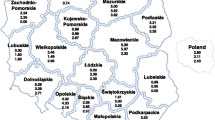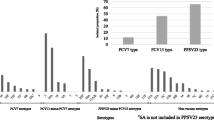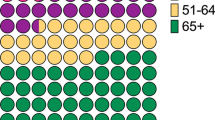Abstract
We evaluated 103 cases of invasive pneumococcal disease (IPD) encountered in 99 children (two developed the disease twice and one, three times) treated in the northern district of Hokkaido (Kamikawa and Soya subprefecture) from April 2000 until March 2010, before the introduction of the 7-valent pneumococcal conjugate vaccine. The main diseases were as follows: pneumonia, 54 cases (52.9%); occult bacteremia, 34 cases (33.3%); meningitis, five cases (4.9%). There were 42 cases during the first half of the study period (from April 2000 to March 2005) and 61 during the second half (from April 2005 to March 2010). The IPD morbidity rate for the 10-year period was 41.3 per 100,000 population in children <5 years and 79.2 per 100,000 population in children <2 years. Serotype analysis of the 77 strains was performed. The most frequent serotype isolated was 6B (31.2%), followed by 23F (14.3%), 19F (13.0%), 9V (7.8%), 6A (7.8%), and 14 (3.9%). The number of strains that could potentially be covered by heptavalent pneumococcal conjugate vaccine was 55 (71.4%), and the number of strains that could potentially be covered by 13-valent pneumococcal conjugate vaccine was 64 (83.1%). Analysis of penicillin-binding protein (PBP) genes was performed of the 82 strains. The percentages of resistant bacteria caused by PBP gene mutations were 42.7% (35 strains) for gPRSP, 48.8% for gPISP (40 strains), and 8.5% for gPSSP (7 strains).


Similar content being viewed by others
References
Sleeman K, Knox K, George R, Miller E, Waight P, Griffiths D, et al. Invasive pneumococcal disease in England and Wales: vaccination implications. J Infect Dis. 2001;183:239–46.
Centers for Disease Control and Prevention (CDC). Direct and indirect effects of routine vaccination of children with 7-valent pneumococcal conjugate vaccine on incidence of invasive pneumococcal disease-United States, 1998–2003. MMWR Morb Mortal Wkly Rep. 2005;54:893–7.
Dias R, Caniça M. Invasive pneumococcal disease in Portugal prior to and after the introduction of pneumococcal heptavalent conjugate vaccine. FEMS Immunol Med Microbiol. 2007;51:35–42.
O’Brien KL, Wolfson LJ, Watt JP, Henkle E, Deloria-Knoll M, McCall N, et al. Burden of disease caused by Streptococcus pneumoniae in children younger than 5 years: global estimates. Lancet. 2009;374:893–902.
Isaacman DJ, McIntosh ED, Reinert RR. Burden of invasive pneumococcal disease and serotype distribution among Streptococcus pneumoniae isolates in young children in Europe: impact of the 7-valent pneumococcal conjugate vaccine and considerations for future conjugate vaccines. Int J Infect Dis. 2010;14:e197–209.
Ubukata K, Chiba N, Hasegawa K, Kobayashi R, Iwata S, Sunakawa K. Antibiotic susceptibility in relation to penicillin-binding protein genes and serotype distribution of Streptococcus pneumoniae strains responsible for meningitis in Japan, 1999 to 2002. Antimicrob Agents Chemother. 2004;48:1488–94.
Ishiwada N, Kurosaki T, Terashima I, Kohno Y. The incidence of pediatric invasive pneumococcal disease in Chiba prefecture, Japan (2003–2005). J Infect. 2008;57:455–8.
Robinson KA, Baughman W, Rothrock G, Barrett NL, Pass M, Lexau C, et al. Epidemiology of invasive Streptococcus pneumoniae infections in the United States, 1995–1998. JAMA. 2001;285:1729–35.
Ispahani P, Slack RC, Donald FE, Weston VC, Rutter N. Twenty year surveillance of invasive pneumococcal disease in Nottingham: serogroups responsible and implications for immunisation. Arch Dis Child. 2004;89:757–62.
Pineda V, Fontanals D, Larramona H, Domingo M, Anton J, Segura F, et al. Epidemiology of invasive Streptococcus pneumoniae infections in children in an area of Barcelona, Spain. Acta Paediatr. 2002;91:1251–6.
Chiba N, Morozumi M, Sunaoshi K, Takahashi S, Takano M, Komori T, et al. Serotype and antibiotic resistance of isolates from patients with invasive pneumococcal disease in Japan. Epidemiol Infect. 2010;138:61–6.
Johnson HL, Deloria-Knoll M, Levine OS, Stoszek SK, Freimanis Hance L, Reithinger R, et al. Systematic evaluation of serotypes causing invasive pneumococcal disease among children under five: the pneumococcal global serotype project. PLoS Med. 2010;7:e1000348.
Aguiar SI, Brito MJ, Gonçalo-Marques J, Melo-Cristino J, Ramirez M. Serotypes 1, 7F and 19A became the leading causes of pediatric invasive pneumococcal infections in Portugal after 7 years of heptavalent conjugate vaccine use. Vaccine. 2010;28:5167–73.
Reinert R, Jacobs MR, Kaplan SL. Pneumococcal disease caused by serotype 19A: review of the literature and implications for future vaccine development. Vaccine. 2010;28:4249–59.
Acknowledgments
I deeply thank Prof. Kimiko Ubukata and coworkers of Laboratory of Molecular Epidemiology for Infectious Agents, Kitasato Institute for Life Science, Kitasato University, for analysis of serotype and PBP gene of S. pneumoniae. This work was supported by grants for a Research Project for Emerging and Re-emerging Infectious Diseases (H-22-013) from the Japanese Ministry of Health, Labour and Welfare.
Author information
Authors and Affiliations
Corresponding author
About this article
Cite this article
Sakata, H. Invasive Streptococcus pneumoniae infections in children in Kamikawa and Soya subprefecture, Hokkaido, Japan, 2000–2010, before the introduction of the 7-valent pneumococcal conjugate vaccine. J Infect Chemother 17, 799–802 (2011). https://doi.org/10.1007/s10156-011-0264-8
Received:
Accepted:
Published:
Issue Date:
DOI: https://doi.org/10.1007/s10156-011-0264-8




